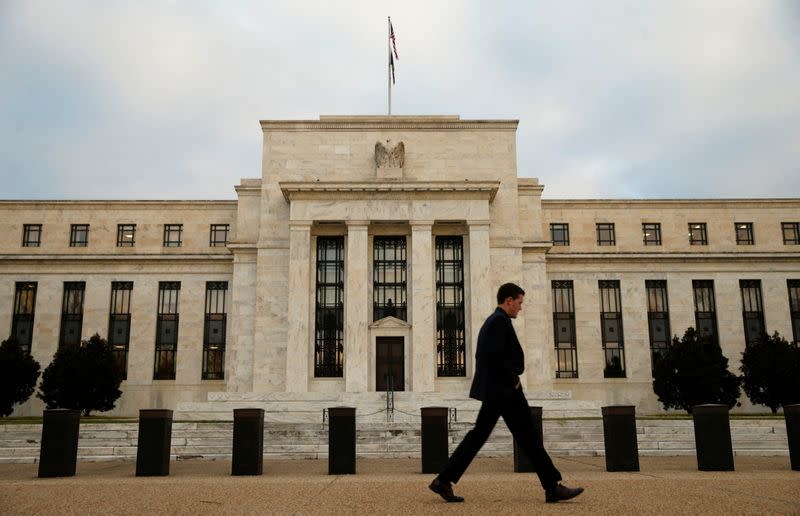US banks suffer steeper losses, but retain large cushions in annual Fed health check

By Pete Schroeder and Nupur Anand
WASHINGTON (Reuters) -The biggest U.S. banks would have enough capital to withstand severe economic and market turmoil, the Federal Reserve's annual "stress test" exercise showed on Wednesday, but firms faced steeper hypothetical losses this year due to riskier portfolios.
The exercise found 31 big banks would weather a spike in the jobless rate, severe market volatility, and dives in the residential and commercial mortgage markets and still retain enough capital to continue lending.
Specifically, the Fed found levels of high-quality capital at the banks would dip to 9.9% at their lowest levels, which is more than twice the regulatory minimum.
The relatively clean bill of health clears the way for the banks to announce capital plans to shareholders in the coming days, including stock buybacks and dividends. Banks can announce capital plans after the market closes on Friday, a senior Fed official said.
"We are positively surprised with the results as we expected losses to be slightly higher compared to the last few years, especially in areas such as commercial real estate," said Chris Marinac, director of research at financial adviser Janney Montgomery Scott. "This shows that the banks are in good health."
However, the test did find banks suffered steeper losses this year. The 2024 version of the stress test was broadly similar to last year's, and the Fed said the higher losses were due to how bank portfolios have shifted.
The banks that were tested would suffer a combined $685 billion in losses under a hypothetical severe scenario. On average, banks saw their capital ratios fall by 2.8 percentage points, the steepest decline since 2018.
Of the banks tested, Charles Schwab Corp reported the highest capital levels under the test, posting a 25.2% capital ratio under that severe scenario. Bank of New York Mellon Corp, JPMorgan Chase, Morgan Stanley, Northern Trust and State Street all reported double-digit capital ratios after the test, as did the US operations of Deutsche Bank and UBS.
By comparison, some smaller regional lenders saw their capital levels skirt closer to the minimums, with BMO, Citizens Financial Group, and HSBC all reporting stressed capital ratios below 7%.
The largest global banks all posted capital ratios well above minimums, with JPMorgan posting the highest at 12.5%, and Wells Fargo the lowest at 8.1%. Bank of America posted a 9.1% capital ratio, and Citigroup posted a 9.7% ratio.
The banking industry hailed the latest results as proof that banks are solid, and criticized efforts by the Fed and other regulators to boost big bank capital requirements.
"The continued strength and resilience of the banking sector is further evidence that the recent tsunami of new regulation, including proposed higher capital standards, is unwarranted," said Rob Nichols, CEO of the American Bankers Association, in a statement.
STEEPER LOSSES
The Fed singled out credit cards as a particular source of losses for banks, accounting for over a quarter of hypothetical losses. The Fed noted that large bank credit card balances have grown by over $100 billion in the last year, and delinquency rates have risen by over 40%.
The tested banks overall saw losses of 17.6% to existing loan balances on credit cards, but Ally Financial experienced losses of 40.6% in the test on its relatively small credit card portfolio. Capital One, one of the nation's largest credit card banks, experienced losses of 23.2%, and Goldman Sachs recorded 25.4% in losses.
The Fed also said that banks' corporate credit portfolios have shifted towards riskier loans, and they now hold a larger share of non-investment grade corporate credit, with these loans more than three times more likely to default than investment grade ones.
In the 2024 stress test, banks were projected to lose $142 billion on commercial and industrial (C&I) loans, representing 21% of total projected losses. C&I loans are made to businesses and can include working capital advances, term loans and loans to individuals for business purposes.
Discover Financial, which Capital One hopes to buy pending regulatory approval, posted the steepest commercial and industrial loan losses at 21.8%.
The Fed also flagged that non-interest income at banks from items like investment fees have declined significantly in recent years, while non-interest expenses like compensation and real estate costs have not.
While banks were expected to perform well under this year's exam as they have in years prior, the annual results are significant for each firm because how well they perform dictates how much capital they must hold against potential losses. Excess funds beyond those capital levels can then be returned to shareholders.
(Reporting by Pete Schroeder, editing by Deepa Babington)

 Yahoo Finance
Yahoo Finance 